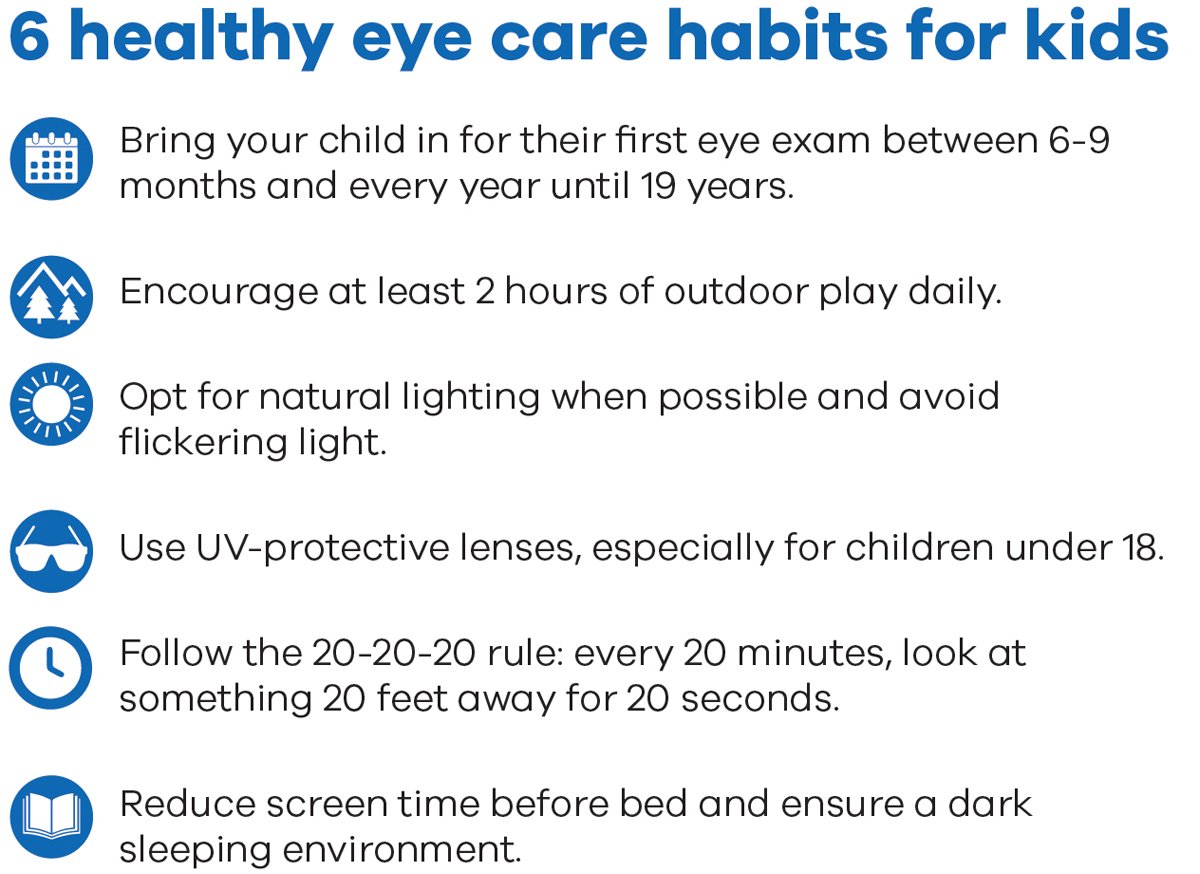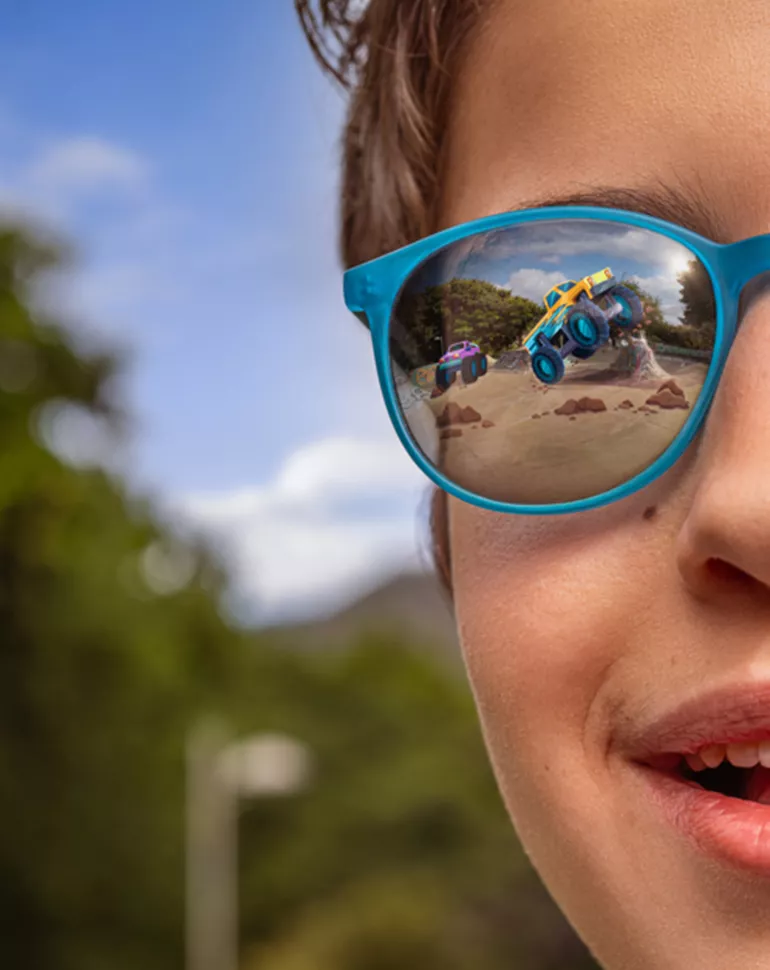Each new school year, we focus on preparing our kids with new clothes, school supplies, and even dental checkups. But how often do we think about children’s eye health? Just like brushing teeth and washing hands, taking care of our eyes is essential for overall well-being.
Good ocular hygiene can help prevent myopia and other vision issues in children, setting them up for academic success and a lifetime of healthy vision. In this post, we'll explore six essential eye care habits to help your young patients maintain optimal eye health.
Importance of children’s eye health
Good eye health is an underestimated part of overall well-being and plays a key role in a child's academic success. Just like we prioritize doctor visits and dental hygiene, maintaining good vision health should be a focus as children head back to school.
Ensuring healthy vision from a young age helps children feel and perform their best in school. Vision problems can often go unnoticed, leading to difficulties in reading, writing, and concentrating in class. By prioritizing eye health, we can set children up for success both academically and in their everyday lives.
Building healthy vision habits
Establishing good eye care habits early on is crucial for maintaining healthy vision in children. Many of these habits aren't on your patients' radar, so it's up to you to provide this valuable education. By doing so, you help prevent common vision problems.
Here are six essential eye care habits to discuss with your young patients.

1. Schedule regular eye exams
Inform parents that school-age children should have a comprehensive eye exam every twelve months until age 19.
According to the Canadian Association of Optometrists, early detection and treatment of vision problems can prevent developmental delays and improve academic performance. Regular eye exams are essential to identify issues like myopia, hyperopia, and astigmatism, which can significantly impact a child's ability to learn and succeed in school.
Ensuring that children have regular eye exams helps catch and address these issues early, giving them the visual tools they need to thrive academically.
Pro Tip: Schedule children’s eye exams around the same time each year – right before school starts. This ensures their vision is checked regularly and any issues can be addressed before they impact their academic performance.
2. Encourage outdoor play to prevent myopia
A study conducted in Taiwan found that increased outdoor time significantly reduces myopic progression in children¹. Children who spent more time outdoors had less myopic progression compared to those who spent more time indoors.
Encourage at least 2 hours of outdoor play daily. This exposure to natural light not only promotes healthy vision but also overall physical health and well-being.
Pro Tip: Recommend HOYA’s photochromic and polarized lenses to your patients. These lenses protect children's eyes from harmful UV rays while they enjoy outdoor activities, helping to reduce the risk of myopia progression.
3. Choose quality lighting
Many parents may not realize that not all lighting is equal, so take time to educate them about the differences during exams.
Good quality lighting can reduce eye strain and improve focus. Natural light is best, but when that's not possible, use bright, non-flickering artificial light. Avoid dim lighting, which can cause eye fatigue and strain. Ensuring that study areas are well-lit can help children concentrate better and protect their vision.
Pro Tip: Position desks and study areas near windows to maximize natural light. For evening study sessions, use LED bulbs that provide consistent, bright light without flickering.
4. Protect against UV exposure
Children's eyes are particularly vulnerable to UV damage, which can lead to serious eye conditions later in life. According to the BC Doctors of Optometry, children receive approximately three times the annual UV dose of adults because they spend more time outdoors and their eyes have less natural protection against UV rays. Additionally, the Canadian Association of Optometrists states that up to 50% of a person's lifetime exposure to UV rays occurs before the age of 18.
Prolonged UV exposure can increase the risk of cataracts, macular degeneration, and other eye conditions. Encourage children to protect their eyes whenever they are outdoors.
Pro Tip: Let your patients know that there are cost-effective options to ensure their children’s eyes are protected. For instance, HOYA Vision Care Canada offers MiYOSMART sun lenses at the same price as clear lenses, making sun protection more affordable.
5. Combat natural digital eye strain and near work
Digital eye strain, also known as computer vision syndrome, occurs when eyes are overused from prolonged screen time and other near work. Symptoms include headaches, dry eyes, blurred vision, and neck and shoulder pain. When focusing on screens or close-up tasks, the blink rate decreases significantly, leading to dry eyes and discomfort.
To mitigate digital eye strain, parents should encourage children to hold reading materials at an appropriate distance (about 14-16 inches from the eyes) and follow the 20-20-20 rule: every 20 minutes, take a 20-second break to look at something 20 feet away. Additionally, setting healthy screen time limits and ensuring breaks between prolonged screen use can help reduce strain on young eyes.
Pro Tip: Recommend HOYA Vision Care Canada’s Sync IIITM and blue light filtering options to your patients. These lenses are designed to reduce digital eye strain by providing enhanced focusing power and filtering out harmful blue light from screens, making them ideal for children who spend significant time on digital devices.
6. Promote healthy sleep practices
Adequate sleep is important for many aspects of our health, including our eyes. Exposure to blue light from screens can interfere with sleep patterns by disrupting circadian rhythms, making it harder for children to fall asleep and stay asleep. Studies have shown that blue light exposure before bedtime can reduce the production of melatonin, a hormone that regulates sleep².
To make sure children get the rest they need, encourage practices such as reducing screen time before bed and creating a dark, quiet sleeping environment. Limiting the use of digital devices at least an hour before bedtime can significantly improve sleep quality.
Pro Tip: Using night mode settings on devices and providing children with blue light filtering glasses can also help minimize the impact of blue light on their sleep.
Tips to engage your patients about ocular hygiene
As Eye Care Professionals, your role is to educate your patients about the importance of good ocular hygiene and eye health. Here are some fun and creative ways to communicate these habits to your patients and their kids:
- Educational Materials: Provide brochures or pamphlets that summarize these best practices. These can be handed out during appointments or made available in your office for patients to take home.
- Social Media: Share action-oriented tips on your social media channels. This helps reach a broader audience and reinforces the importance of ocular hygiene outside of the office.
- Workshops: Host short-form community workshops to discuss these habits with parents and children. This interactive approach can make the information more engaging and memorable.
- Office Posters: Display posters in the office that highlight these best practices. Visual reminders can reinforce the message every time patients visit.
- Direct Communication: Discuss these tips during consultations and follow-up appointments. Personalized advice can be very impactful.
Ensuring healthy vision for children
By encouraging these ocular hygiene habits, you can help your patients maintain healthy vision and achieve academic success. HOYA Vision Care Canada is here to support you in this mission.
If you need additional resources or assistance, we are always here to help. Together, let's ensure a brighter, clearer future for every child.
References:
¹ Yang YC, Hsu NW, Wang CY, Shyong MP, Tsai DC. The Prevalence Trend of Myopia after Promoting Outdoor Activity among Preschoolers, 2014-2019: A Serial Cross-sectional Study in Yilan, Taiwan. ARVO 2021 abstract and video presentation.
² University of Haifa. "Blue light emitted by screens damages our sleep, study suggests." ScienceDaily. August 22, 2017. https://www.sciencedaily.com/releases/2017/08/170822103434.htm.
